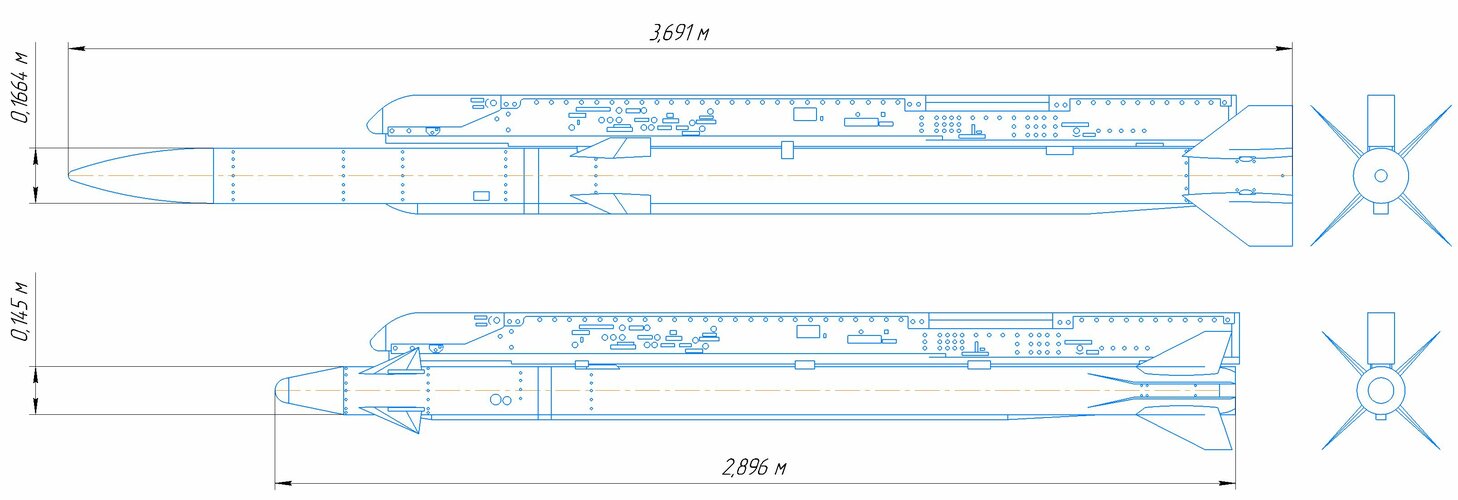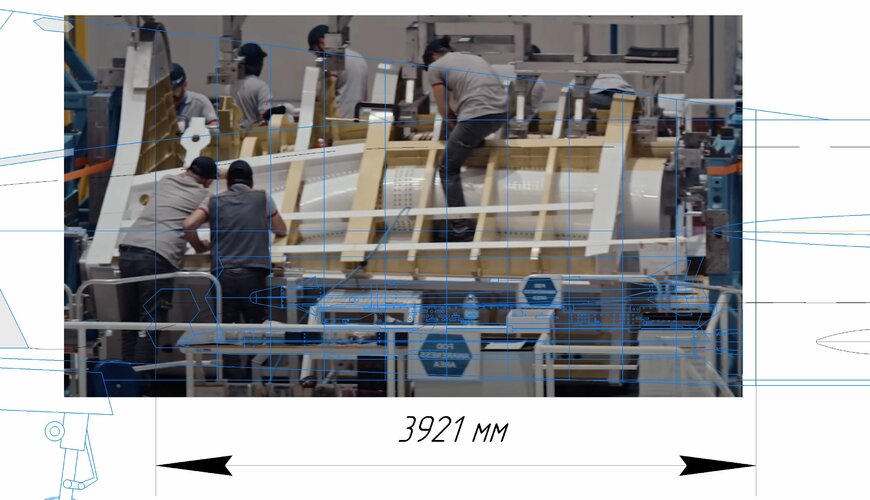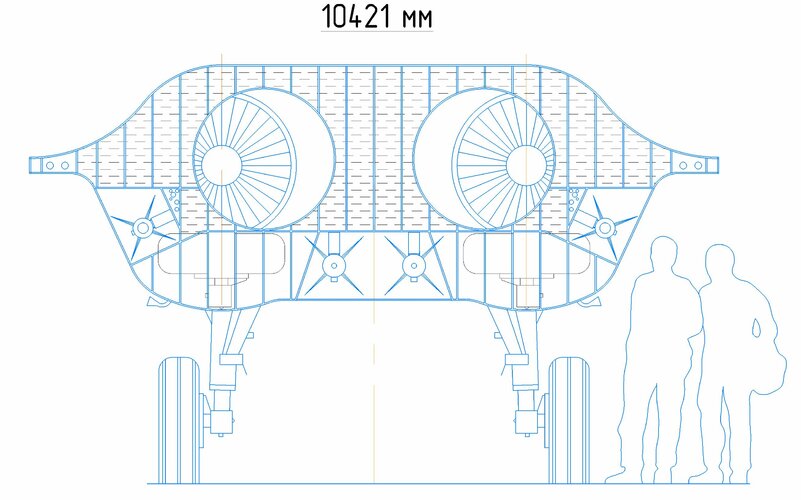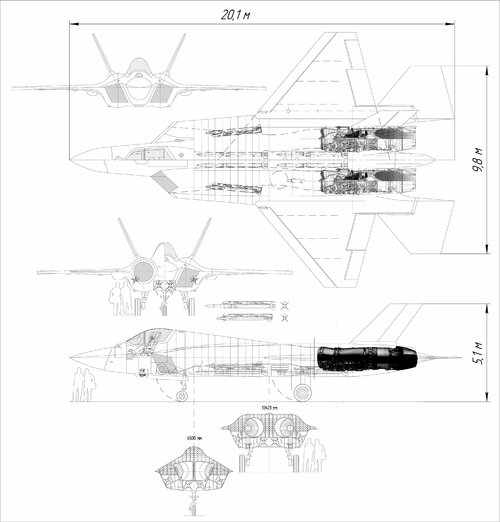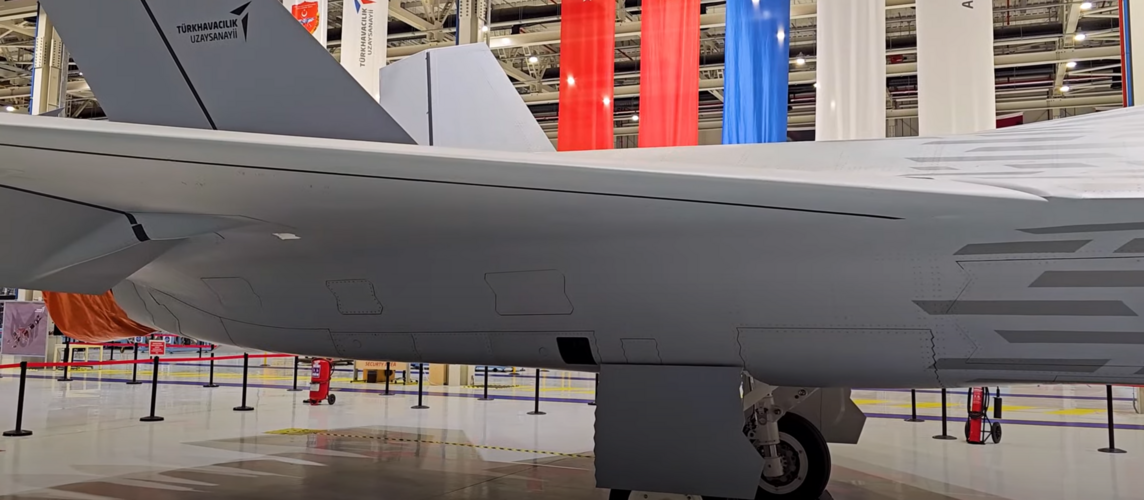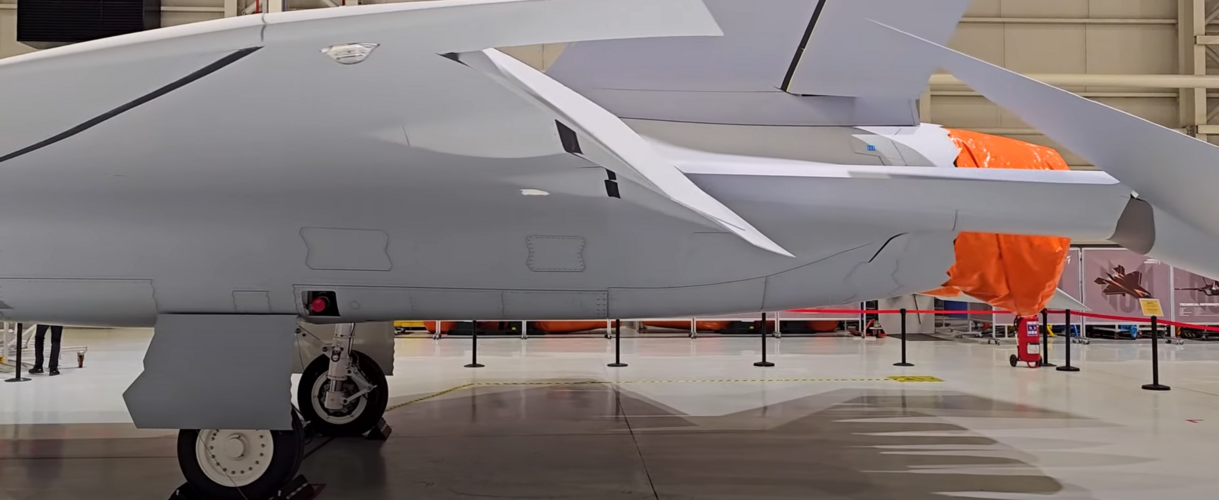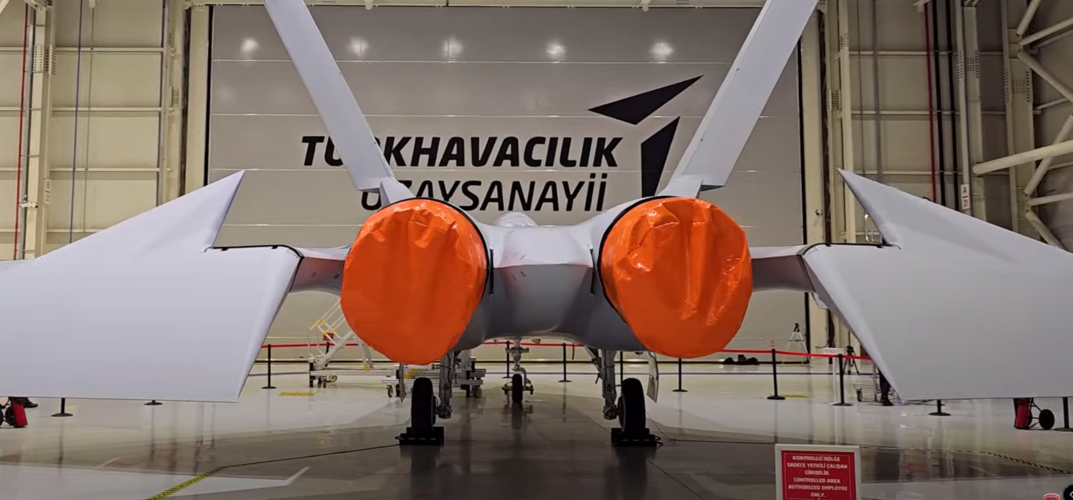You are using an out of date browser. It may not display this or other websites correctly.
You should upgrade or use an alternative browser.
You should upgrade or use an alternative browser.
TAI TF-X / Milli Muharip Uçak MMU Kaan
- Thread starter ocay
- Start date
- Joined
- 15 July 2020
- Messages
- 1,493
- Reaction score
- 4,593
Excellent work!Frame
Here's a centre fuselage bulkhead of the KAAN, you can see the bottom two slots that's where the main landing gears tyres fold into a slight angle

My frame is in place of this one, and this one is next 
- Joined
- 15 July 2020
- Messages
- 1,493
- Reaction score
- 4,593
Another image of the demo aircraft


Radonislav
ACCESS: Confidential
- Joined
- 16 November 2022
- Messages
- 152
- Reaction score
- 214
It is impossible to achieve accuracy in millimeters or even centimeters from photographs, so you should not strive for this. The official area of the wing is 70 m2, in my drawing it turned out that way
Your question is most legitimate, and I will try to answer it as best as possible :I have big doubts on the fact that this aircraft can fly, as it is depicted here.
- Turkey does not have an operational fly by wire system yet. It is probably the most complex part to design in a modern fighter aircraft. For now, they are still working on it, but it may take years before Kaan can take off, as an unstable and FBW driven plane. Therefore, Turkey may still have a extensive amount of design reworks to perform to reach the final result. Even for major nations of aerospace, like USA, Russia, France, UK, Sweden, China and Japan it was really hard to get operational fly by wire systems. Just remember that first F-16 almost crashed, First JAS-39 was destroyed, and T-2CCV almost stall when raising main undercarriage. Therefore, it's not impossible, but it's gonna be really difficult for them to get a good FBW system, while we all know that during the rollout of Kaan, they had issues to maintain a straight line on ground. Even China got an operational analog FBW system from a given F-16 but also from Lavi technology in the 80s. You will also note that to operate such a complex aircraft as Kaan, a analog FBW may not be sufficient. Therefore, a digital FBW computer may be necessary, to operate Kaan within such a complex flight enveloppe that what specifications demands.
- Aircraft itself is huge. While it is believed to be in the end an unstable fighter to have the best maneuverability and without thrust vector control, this aircraft will nevetheless have to sustain high AOA and Gs, which J-20 for example is not capable to perform, which shares a close size with Kaan. Therefore, I think that the choice of a big fighter like that wasn't so wise, but unfortunately necessary, for power plant reasons. A fighter aircraft is indeed always designed around its power plant. Because of its alliances, the only engine that was sufficient for Kaan's specifications was the GE-129. The other candidates wouldn't have had sufficient power to match Kaan's requirements, including supercruise capability (I don't believe that Kaan will anyway ever get a mach 1.2+ supercruise asset, and will remain like Rafale, Eurofighter or F-35). So, aircraft has been necessary designed as huge, to store the big amount of necessary fuel for the mission this aircraft is supposed to have, from MoD's specifications. Also, I feel doubtful that these engines may be compatible with a stealth application. I then think that this aircraft will have a RCS optimization, like KF-21 or Rafale, rather than being a full stealth fighter like F-22 or F-35. F-119 and F-135 engines were specifically designed to for a stealthy application. It was never the case for F-110 GE-129.
- Aerodynamically speaking, I have no figures to illustrate my statements, but there is some stuff I feel a bit concerned by :
- Cockpit position. I suspect possible instability issues from the unprogressive design of the cockpit area. On J-35, which shares a similar configuration, it looks much smoother.
- Wing angle of attack : it's surprising to have the choice of a negative wing pitch angle, while Kaan's heading line is slightly positive. I suspect that it was a compensation solution rather than a performance optimization concept.
- I don't have enough views to exactly precise my understanding, but geometry of J-22 and F-35 are smoothy everywhere, with a very complex structure (F-22 wing for example is just an heaven of aerodynamic engineering). On Kaan, it looks so straight, and I feel a bit surprised by this choices. Even on J-35 and KF-21 airframe is smooth and progressive.
Radium
Incorrect. This aircraft will fly. Turkey does have an operational FBW system. Kaan in particular has fly-by-optics.Don't take me wrong : I really wish all the best for Kaan. But I believe that if it flies one day, she will have a quite different design that what we see now. Like F-22 for example !
Radium
Last edited by a moderator:
Did it flew ? No. We will see when it does !Incorrect. This aircraft will fly. Turkey does have an operational FBW system. Kaan in particular has fly-by-optics.
TAI Hürjet flew for now without FBW. But it's expected to have one. Beside that, it's important to make a difference between a stability control FBW and an instability control FBW, which are totally different concepts ! From what I see, TAI Hürjet will have a stability control FBW, while Kaan shall have a instability control FBW.
Beside that, you say incorrect, but it's your speech against mine ! While I wrote 20 lines against one "incorrect". Light isn't it ?
Having a plan for does not means operational. Look GTRE GTX-35VS Kaveri. Even it flew, it never became operational.
Will have, because even official said that it wasn't implemented yet in the aircraft.Kaan in particular has fly-by-optics
I don't like plans and pieces of expectancy, I like reality !
Last edited by a moderator:
snne
ACCESS: Top Secret
- Joined
- 3 July 2022
- Messages
- 1,390
- Reaction score
- 4,520
Go to Hurjet/Anka-3/F-16 Ozgur threads please. With all due respect, your opinion is simply outdated. We all would've agreed with you had you told us these a couple of years ago but at this date you are a bit behind when it comes to Turkish aviation matters.
I don't like plans and pieces of expectancy, I like reality !
All that info is available to you at a single click, he shouldn't have to explain everything to you at page 29.
You should first visit english language media/forums such as Defence Turkey, MSI, DefenceTurk and Defencehub or you can even go a couple of pages back to see all the discussions we've had and the news we've shared. But coming here out of knowhere and blindly claiming something without first reading a bit is in my opinion a bit discrediting against all the work of the people involved.
Edit: Your references are all over the place, mate. None of them are really comparable. You gave India as an example but Turkish and Indian project managements/industrial participation and development are totally different and thus it is not a valid argument. What may have worked in case of one country may not work for another or you can't expect x country to follow the same route just because y country followed this project management.
Aside from that, this project has been in active development for more than a decade and all of these design elements are there not because of someone playing with CAD getting inspired but because of countless hours of testing and evaluation.
Last edited by a moderator:
TAI Hürjet flew with an active FBW
I don't like plans and pieces of expectancy, I like reality !
Last edited by a moderator:
djfawcett
With Enough Power, Anything Will Fly
- Joined
- 16 December 2012
- Messages
- 274
- Reaction score
- 422
I would accept the released dimensions of 21m length and 14m span until such time additional specs are given. You are debating a difference of inches using comparative analysis. Trust me, it eliminates brain hurt - lol.@paralay are you sure that Kaan is 20.1 meters (L) to 13.3 meters (W)? Because I found around. 20.9 to 13.9 when I overlaid a F-16 Block 40M of TurAF used engines as a scale? Can you do the same and share the results?
It’s just an endless fanboy versus pros and cons debate. Let it fly, and become operational, I will be happy to shut up. For now, we have a powered airframe on the ground. And when it would have fly, it can still be cancelled for various reasons, like IAI Lavi.Go to Hurjet/Anka-3/F-16 Ozgur threads please. With all due respect, your opinion is simply outdated. We all would've agreed with you had you told us these a couple of years ago but at this date you are a bit behind when it comes to Turkish aviation matters.
I don't like plans and pieces of expectancy, I like reality !
All that info is available to you at a single click, he shouldn't have to explain everything to you at page 29.
You should first visit english language media/forums such as Defence Turkey, MSI, DefenceTurk and Defencehub or you can even go a couple of pages back to see all the discussions we've had and the news we've shared. But coming here out of knowhere and blindly claiming something without first reading a bit is in my opinion a bit discrediting against all the work of the people involved.
Edit: Your references are all over the place, mate. None of them are really comparable. You gave India as an example but Turkish and Indian project managements/industrial participation and development are totally different and thus it is not a valid argument. What may have worked in case of one country may not work for another or you can't expect x country to follow the same route just because y country followed this project management.
Aside from that, this project has been in active development for more than a decade and all of these design elements are there not because of someone playing with CAD getting inspired but because of countless hours of testing and evaluation.
Yes but Hürjet is gnot naturally unstable, like Kaan is going to be, alike most modern jets.TAI Hürjet flew with an active FBW
I don't like plans and pieces of expectancy, I like reality !
Just to let you know : I am super impressed by Kızılelma. It’s just amazing and big kudos to Turkish teams for this achievement.
There is no partiality in what I say : I just look at facts, not expectancies.
Last edited:
Radonislav
ACCESS: Confidential
- Joined
- 16 November 2022
- Messages
- 152
- Reaction score
- 214
Well
My point was that it should be closer (or exact) to 21/14, rather than 20/13. That .X part was a bit unnecessary yesI would accept the released dimensions of 21m length and 14m span until such time additional specs are given. You are debating a difference of inches using comparative analysis. Trust me, it eliminates brain hurt - lol.@paralay are you sure that Kaan is 20.1 meters (L) to 13.3 meters (W)? Because I found around. 20.9 to 13.9 when I overlaid a F-16 Block 40M of TurAF used engines as a scale? Can you do the same and share the results?
Hürjet is a naturally unstable aircraft, like KAAN.Yes but Hürjet is gnot naturally unstable, like Kaan is going to be, alike most modern jets.
Just to let you know : I am super impressed by Kızılelma. It’s just amazing and big kudos to Turkish teams for this achievement.
There is no partiality in what I say : I just look at facts, not expectancies.
Last edited by a moderator:
- Joined
- 15 July 2020
- Messages
- 1,493
- Reaction score
- 4,593
Radonislav
ACCESS: Confidential
- Joined
- 16 November 2022
- Messages
- 152
- Reaction score
- 214
Hürjet is a naturally unstable aircraft, like KAAN.
Maybe the final aircraft yes, but not the aircraft that already flew ! As you can see on the video available, there is no sign on stability control, That being said I just love Hürjet, it's a lovely little airplane with great capabilities, and an incredible achievement for Turkish Industry.
But as I said before and that was misunderstood, I am no fanboy by any mean : I just analyse what I see, and what I can analyze from the data available. By the way, I love it's new livery ! It makes me think about Switzerland former Hawk !
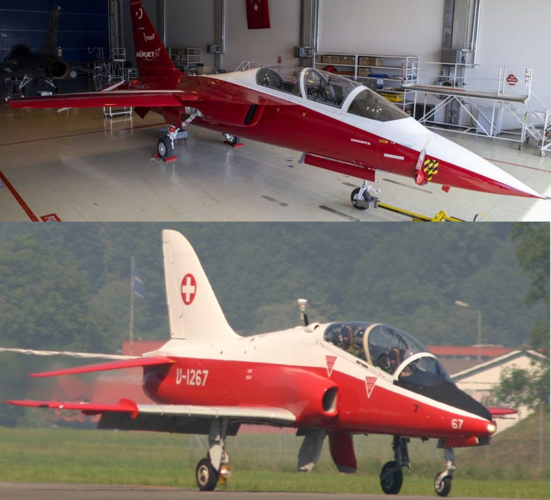
Congratulation Turkey for Hürjet !
Radium
Last edited by a moderator:
Radonislav
ACCESS: Confidential
- Joined
- 16 November 2022
- Messages
- 152
- Reaction score
- 214
"As you can see on the video available, there is no sign on stability control" then how did it fly bro cmon
Maybe the final aircraft yes, but not the aircraft that already flew ! As you can see on the video available, there is no sign on stability control,
Last edited by a moderator:
Like Hawk, Alpha-Jet, L-159, AT-3, T-4, T-38... Aircraft is naturally stable, so you don't need artificial stability control for it"As you can see on the video available, there is no sign on stability control" then how did it fly bro cmon
Last edited by a moderator:
- Joined
- 15 July 2020
- Messages
- 1,493
- Reaction score
- 4,593
Maybe the final aircraft yes, but not the aircraft that already flew ! As you can see on the video available, there is no sign on stability control,
Both the tail and wing of Hurjet are lifting surfaces, so how you're surmising that Hurjet is a stable aircraft ?
Last edited by a moderator:
Hürjet is a naturally unstable aircraft, like KAAN.It’s just an endless fanboy versus pros and cons debate. Let it fly, and become operational, I will be happy to shut up. For now, we have a powered airframe on the ground. And when it would have fly, it can still be cancelled for various reasons, like IAI Lavi.Go to Hurjet/Anka-3/F-16 Ozgur threads please. With all due respect, your opinion is simply outdated. We all would've agreed with you had you told us these a couple of years ago but at this date you are a bit behind when it comes to Turkish aviation matters.
I don't like plans and pieces of expectancy, I like reality !
All that info is available to you at a single click, he shouldn't have to explain everything to you at page 29.
You should first visit english language media/forums such as Defence Turkey, MSI, DefenceTurk and Defencehub or you can even go a couple of pages back to see all the discussions we've had and the news we've shared. But coming here out of knowhere and blindly claiming something without first reading a bit is in my opinion a bit discrediting against all the work of the people involved.
Edit: Your references are all over the place, mate. None of them are really comparable. You gave India as an example but Turkish and Indian project managements/industrial participation and development are totally different and thus it is not a valid argument. What may have worked in case of one country may not work for another or you can't expect x country to follow the same route just because y country followed this project management.
Aside from that, this project has been in active development for more than a decade and all of these design elements are there not because of someone playing with CAD getting inspired but because of countless hours of testing and evaluation.
Yes but Hürjet is gnot naturally unstable, like Kaan is going to be, alike most modern jets.TAI Hürjet flew with an active FBW
I don't like plans and pieces of expectancy, I like reality !
Just to let you know : I am super impressed by Kızılelma. It’s just amazing and big kudos to Turkish teams for this achievement.
There is no partiality in what I say : I just look at facts, not expectancies.
Maybe the final aircraft yes, but not the aircraft that already flew ! As you can see on the video available, there is no sign on stability control, That being said I just love Hürjet, it's a lovely little airplane with great capabilities, and an incredible achievement for Turkish Industry.
But as I said before and that was misunderstood, I am no fanboy by any mean : I just analyse what I see, and what I can analyze from the data available. By the way, I love it's new livery ! It makes me think about Switzerland former Hawk !
View attachment 700017
Congratulation Turkey for Hürjet !
Radium
Both the tail and wing of Hurjet are lifting surfaces, so how you're surmising that Hurjet is a stable aircraft ?
Hello,
there is 3 kind of fighter aircraft control system :
- Mechanical control system (F-4 phantom for example)
- Stable aircraft fly by wire system (Airbus A320 for example)
- Unstable fly by wire system (F-16 for example)
- Analog fly by wire system (F-16 block 15 for example)
- Digital fly by wire system (F-16 block 52 for example)
- Fly by light system (Kawasaki P-1 for example)
For which reason would we desire this kind of unstable aircraft ? To get flight dynamics that couldn't be reached with a stable aircraft, especially regarding AoA (angle of attack), or due to complex and abnormal aerodynamic specifications (F-117).
From it's design, and its specifications, Kaan will be necessarily an unstable fighter like F-22, F-35, Rafale, F-16 for example.
For Hürjet, its design does not apparently and specifically needs a fly by wire system to operate as its global concept is rather common for an advanced training fighter jet. I have no information regarding it's weight charts, to guess how it's centered. I would have then three remarks :
- It's totally possible that for early tests, the aircraft would be forward centered, then, fly by wire wouldn't be needed
- After early tests achieved, it would be possible to implement a stable aircraft fly by wire system, if some flight domain protection functionalities are needed for example, or if Turkey wants to use it as a practical test bed for other application
- The aircraft in its final definition, might be naturally unstable (especially with the final internal fuel tanks configuration), and then, a full unstable fly by wire system may be implemented.
Best regards,
Radium
Last edited:
- Joined
- 21 April 2009
- Messages
- 13,759
- Reaction score
- 7,700
Question for the esteemed experts on this forum. My guess it may have been answered on some thread somewhere so I apologize in advance for redundancy if applicable.
While every “stealth” aircraft/airframe is different is there a general rule of thumb between stealth shape and the stealth coatings contribution to the final “stealthiness”? Is shape 80% coatings 20% (obviously very rudimentary thinking on my part). Or is assessing individual attributes to stealth this way too complicated? Thanks
While every “stealth” aircraft/airframe is different is there a general rule of thumb between stealth shape and the stealth coatings contribution to the final “stealthiness”? Is shape 80% coatings 20% (obviously very rudimentary thinking on my part). Or is assessing individual attributes to stealth this way too complicated? Thanks
Hello,Question for the esteemed experts on this forum. My guess it may have been answered on some thread somewhere so I apologize in advance for redundancy if applicable.
While every “stealth” aircraft/airframe is different is there a general rule of thumb between stealth shape and the stealth coatings contribution to the final “stealthiness”? Is shape 80% coatings 20% (obviously very rudimentary thinking on my part). Or is assessing individual attributes to stealth this way too complicated? Thanks
it’s hard to reply because every manufacturer has its secrets
So stealth highly depend on other technologies than shape itself !
Radium
This is a very big secret RCS TF-X 0.5 m2 without external weapons and 6.5 m2 with external. This is at the level of other inconspicuous aircraft
Calculation:
Front view area 10 m2
number of consoles 6 pieces (2 wings, 2 stabilizers, 2 keels)
coating 0.5
structural solutions 0.2
minimum RCS: 10 m2 / 2 * 6 pieces / 6 * 0.5 * 0.2 = 0.5 m2
Calculation:
Front view area 10 m2
number of consoles 6 pieces (2 wings, 2 stabilizers, 2 keels)
coating 0.5
structural solutions 0.2
minimum RCS: 10 m2 / 2 * 6 pieces / 6 * 0.5 * 0.2 = 0.5 m2
- Joined
- 15 July 2020
- Messages
- 1,493
- Reaction score
- 4,593
Question for the esteemed experts on this forum. My guess it may have been answered on some thread somewhere so I apologize in advance for redundancy if applicable.
While every “stealth” aircraft/airframe is different is there a general rule of thumb between stealth shape and the stealth coatings contribution to the final “stealthiness”? Is shape 80% coatings 20% (obviously very rudimentary thinking on my part). Or is assessing individual attributes to stealth this way too complicated? Thanks
General Manager of TAI was fairly open about this subject in one of his interviews not so far back. As is known, TFX KAANs bulkheads are additive manufactured on massive 3D printers. As such, TAI are experimenting on incorporating "radiation wells" into the metal bulkheads, passively trapping and deflecting R/F signals.
donnage99
ACCESS: Top Secret
- Joined
- 16 June 2008
- Messages
- 1,355
- Reaction score
- 870
a better view of RCS management would be from the requirement standpoint. If you are forced to not have the most ideal shape in one particular area, that means alot more RAM coating you gonna have to use which increases cost, weight, etc.
this perhaps is one of the big challenge of designing a multirole capable 5th gen aircraft. You see it with the f-35. As the need to fit every requirements out there into a limited aerodynamic friendly design, the f-35 end up with humps and bumps across its surfaces, which now dictates more RAM coating and shaping to compensate and meet RCS requirement, which increases weight.
I'm glad Kaan starts out with a big design. That perhaps is a sign of realistic engineering expectation.
this perhaps is one of the big challenge of designing a multirole capable 5th gen aircraft. You see it with the f-35. As the need to fit every requirements out there into a limited aerodynamic friendly design, the f-35 end up with humps and bumps across its surfaces, which now dictates more RAM coating and shaping to compensate and meet RCS requirement, which increases weight.
I'm glad Kaan starts out with a big design. That perhaps is a sign of realistic engineering expectation.
- Joined
- 11 February 2010
- Messages
- 1,650
- Reaction score
- 2,703
While every “stealth” aircraft/airframe is different is there a general rule of thumb between stealth shape and the stealth coatings contribution to the final “stealthiness”? Is shape 80% coatings 20% (obviously very rudimentary thinking on my part). Or is assessing individual attributes to stealth this way too complicated? Thanks
It mostly shape. the rule of thumb is that you would get the first -30 dB of your RCS reduction from shaping, while the remaining -10 dB is from materials. and the cost will increase for every -10 dB reduction as far as i remember, can't really say how big the magnitude of cost increase tho.
the other way to think about it is, you would get the first 1000 times reduction of your RCS from shaping while materials may only get you about 10 times the reduction from the original.
I hope that make sense somehow.
buraktunahan
ACCESS: Restricted
- Joined
- 27 March 2023
- Messages
- 4
- Reaction score
- 11
Your question is most legitimate, and I will try to answer it as best as possible :I have big doubts on the fact that this aircraft can fly, as it is depicted here.
- Turkey does not have an operational fly by wire system yet. It is probably the most complex part to design in a modern fighter aircraft. For now, they are still working on it, but it may take years before Kaan can take off, as an unstable and FBW driven plane. Therefore, Turkey may still have a extensive amount of design reworks to perform to reach the final result. Even for major nations of aerospace, like USA, Russia, France, UK, Sweden, China and Japan it was really hard to get operational fly by wire systems. Just remember that first F-16 almost crashed, First JAS-39 was destroyed, and T-2CCV almost stall when raising main undercarriage. Therefore, it's not impossible, but it's gonna be really difficult for them to get a good FBW system, while we all know that during the rollout of Kaan, they had issues to maintain a straight line on ground. Even China got an operational analog FBW system from a given F-16 but also from Lavi technology in the 80s. You will also note that to operate such a complex aircraft as Kaan, a analog FBW may not be sufficient. Therefore, a digital FBW computer may be necessary, to operate Kaan within such a complex flight enveloppe that what specifications demands.
Hello Radium.
First of all, I should mention that Hürjet has fbw system, that is, Hürjet digital control is an airplane. In fact, the CEO of TAI, Professor Temel KOTİL, has clearly stated this at the press conference. (The movement of the flight control surfaces is provided with the help of the lever called the side-stick and actuators, there is no physical connection between the control surfaces and the side-stick lever).

TUSAŞ GM Temel KOTİL: `Biz Burada Ne Mucizevi Bir Şey Yapıyoruz Ne De Basit Bir İş Yapıyoruz!`
TUSAŞ’ta 6 yılını doldurup 7’inci yılına giren Yönetim Kurulu Üyesi ve Genel Müdür Prof. Dr. Temel KOTİL, 11 Ocak 2023 tarihinde düzenlenen ve 30 basın mensubu tarafından takip edilen Basın Buluşması etkinliğinde 1 saat 40dk süreyle şirketin dünü ve bugünü ile TUSAŞ’ı 10.000 Mühendis ve ABD$10...
 www.defenceturkey.com
www.defenceturkey.com
Initially, the Turkish State and the Turkish Air Force did not have a request for the development of Hürjet. The Turkish Air Force only wanted a 5th generation fighter jet. However, TAI has not designed any jet fighter aircraft before. For this reason, the construction of Hürjet is a decision made by TAI itself. TAI started the Hürjet project as a pre-KAAN experience project.
Currently flying with Hürjet fbw. And its first flight is really close to perfect. F-16 pilots accompanying the first flight asked, "Is this really the first flight?" they asked. Therefore, Turkey has a functioning fbw system and is currently under development. Don't worry about it.
The experience gained from Hürjet is transferred to KAAN. Therefore, the fbw system, which was successful in Hürjet, is integrated into KAAN. However, as the KAAN project was ahead of its own schedule, it caught up with the Hürjet project.
Probably before the end of 2023 or at the beginning of 2024, KAAN will hopefully make its first flight.
Radonislav
ACCESS: Confidential
- Joined
- 16 November 2022
- Messages
- 152
- Reaction score
- 214
How about materials that reduce like -30dBsm? Do you calculate it over the data that you already have (geometry) (1/1000th of 1/1000) or add it as another -30dBsm?While every “stealth” aircraft/airframe is different is there a general rule of thumb between stealth shape and the stealth coatings contribution to the final “stealthiness”? Is shape 80% coatings 20% (obviously very rudimentary thinking on my part). Or is assessing individual attributes to stealth this way too complicated? Thanks
It mostly shape. the rule of thumb is that you would get the first -30 dB of your RCS reduction from shaping, while the remaining -10 dB is from materials. and the cost will increase for every -10 dB reduction as far as i remember, can't really say how big the magnitude of cost increase tho.
the other way to think about it is, you would get the first 1000 times reduction of your RCS from shaping while materials may only get you about 10 times the reduction from the original.
I hope that make sense somehow.
- Joined
- 11 February 2010
- Messages
- 1,650
- Reaction score
- 2,703
How about materials that reduce like -30dBsm? Do you calculate it over the data that you already have (geometry) (1/1000th of 1/1000) or add it as another -30dBsm?
The use of that rule of thumb is rather loose tho. basically you just add that negative value. so let's say we want to design a new plane. simulation suggest from shaping we get -30 dB reduction from a reference e.g 1 sqm or 0 dB and then we have that -30 dB material.
so the total reduction would be -60 dB
- Joined
- 3 June 2011
- Messages
- 18,339
- Reaction score
- 12,241
Are those aluminum skins?
Fully composite.Are those aluminum skins?That's a lot of fasteners for a composite skin.
Your question is most legitimate, and I will try to answer it as best as possible :I have big doubts on the fact that this aircraft can fly, as it is depicted here.
- Turkey does not have an operational fly by wire system yet. It is probably the most complex part to design in a modern fighter aircraft. For now, they are still working on it, but it may take years before Kaan can take off, as an unstable and FBW driven plane. Therefore, Turkey may still have a extensive amount of design reworks to perform to reach the final result. Even for major nations of aerospace, like USA, Russia, France, UK, Sweden, China and Japan it was really hard to get operational fly by wire systems. Just remember that first F-16 almost crashed, First JAS-39 was destroyed, and T-2CCV almost stall when raising main undercarriage. Therefore, it's not impossible, but it's gonna be really difficult for them to get a good FBW system, while we all know that during the rollout of Kaan, they had issues to maintain a straight line on ground. Even China got an operational analog FBW system from a given F-16 but also from Lavi technology in the 80s. You will also note that to operate such a complex aircraft as Kaan, a analog FBW may not be sufficient. Therefore, a digital FBW computer may be necessary, to operate Kaan within such a complex flight enveloppe that what specifications demands.
Hello Radium.
First of all, I should mention that Hürjet has fbw system, that is, Hürjet digital control is an airplane. In fact, the CEO of TAI, Professor Temel KOTİL, has clearly stated this at the press conference. (The movement of the flight control surfaces is provided with the help of the lever called the side-stick and actuators, there is no physical connection between the control surfaces and the side-stick lever).

TUSAŞ GM Temel KOTİL: `Biz Burada Ne Mucizevi Bir Şey Yapıyoruz Ne De Basit Bir İş Yapıyoruz!`
TUSAŞ’ta 6 yılını doldurup 7’inci yılına giren Yönetim Kurulu Üyesi ve Genel Müdür Prof. Dr. Temel KOTİL, 11 Ocak 2023 tarihinde düzenlenen ve 30 basın mensubu tarafından takip edilen Basın Buluşması etkinliğinde 1 saat 40dk süreyle şirketin dünü ve bugünü ile TUSAŞ’ı 10.000 Mühendis ve ABD$10...www.defenceturkey.com
Initially, the Turkish State and the Turkish Air Force did not have a request for the development of Hürjet. The Turkish Air Force only wanted a 5th generation fighter jet. However, TAI has not designed any jet fighter aircraft before. For this reason, the construction of Hürjet is a decision made by TAI itself. TAI started the Hürjet project as a pre-KAAN experience project.
Currently flying with Hürjet fbw. And its first flight is really close to perfect. F-16 pilots accompanying the first flight asked, "Is this really the first flight?" they asked. Therefore, Turkey has a functioning fbw system and is currently under development. Don't worry about it.
The experience gained from Hürjet is transferred to KAAN. Therefore, the fbw system, which was successful in Hürjet, is integrated into KAAN. However, as the KAAN project was ahead of its own schedule, it caught up with the Hürjet project.
Probably before the end of 2023 or at the beginning of 2024, KAAN will hopefully make its first flight.
Hello,
Biggest issue here is that nobody really reads what I write. That's a bit disappointing.
Most comments are mostly enthusiastic, but first principle of science is doubt.
I understand that it's a big pride for Turkey to see this birds, I only see a big gap between announcements, and what I see by my eyes, after years of aerospace engineering and flying combat aircraft in real life.
I wrote that I doubt that there is a fly by wire system on Hürjet, because there is no sign or artifical stability control on surface.
You said it yourself :
The movement of the flight control surfaces is provided with the help of the lever called the side-stick and actuators, there is no physical connection between the control surfaces and the side-stick lever
It does not means at any moment that there is a stability control. It says that Hürjet is a fully electronically wired aircraft with probably some flight domain limitations which is fairly logical, and such assumption never raised any kind doubt by my side.
But for now, I didn't see any proof of a stability control, which is the main purpose of a fighter aircraft full flight by wire system.
I just checked it : even on M346 which is the same class of advanced training aircraft we can clearly see that there is a stability control.
Currently flying with Hürjet fbw. And its first flight is really close to perfect. F-16 pilots accompanying the first flight asked, "Is this really the first flight?" they asked. Therefore, Turkey has a functioning fbw system and is currently under development. Don't worry about it.
I don't worry for anything ! first I own no TAI shares, and my country has no link with Turkish military aerospace complex. But seeing the impressive communication policy deployed, I would have been surprised of reading it differently. I really never really care about such feedback, because as a military personal, you must say what PR people ask you to say, it's the same in every country.
I can't wait to see more of the final Kaan and the final Hürjet
And before people jump on by back :
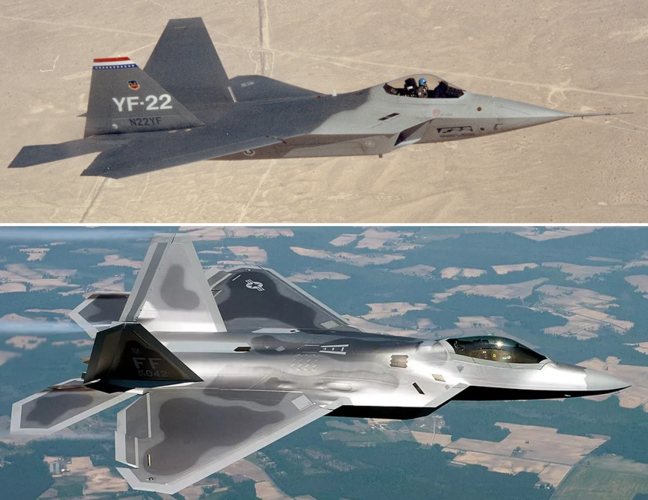
When I say "final", I mean this : YF-22 and F-22 were totally different airplanes that share almost nothing in common together. I consider that Kaan is for now YF-22 before it's first flight. Final Kaan will be very different, I believe, as it was for F-22 and F-35 for example : fighter aircraft engineering is like that.
Radium
Last edited:
Radonislav
ACCESS: Confidential
- Joined
- 16 November 2022
- Messages
- 152
- Reaction score
- 214
Nope, composites, I had the production sheet saved somewhere, maybe @Canardzz or @Combat-Master could post itAre those aluminum skins?That's a lot of fasteners for a composite skin.
Last edited:
Radonislav
ACCESS: Confidential
- Joined
- 16 November 2022
- Messages
- 152
- Reaction score
- 214
What do you mean by "stability control", how did you notice or didn't notice that from a small clip with minimal maneuvers and why would TAI fly it without FBW, what if something just goes wrong? Much of a risk to take without a reasonYour question is most legitimate, and I will try to answer it as best as possible :I have big doubts on the fact that this aircraft can fly, as it is depicted here.
- Turkey does not have an operational fly by wire system yet. It is probably the most complex part to design in a modern fighter aircraft. For now, they are still working on it, but it may take years before Kaan can take off, as an unstable and FBW driven plane. Therefore, Turkey may still have a extensive amount of design reworks to perform to reach the final result. Even for major nations of aerospace, like USA, Russia, France, UK, Sweden, China and Japan it was really hard to get operational fly by wire systems. Just remember that first F-16 almost crashed, First JAS-39 was destroyed, and T-2CCV almost stall when raising main undercarriage. Therefore, it's not impossible, but it's gonna be really difficult for them to get a good FBW system, while we all know that during the rollout of Kaan, they had issues to maintain a straight line on ground. Even China got an operational analog FBW system from a given F-16 but also from Lavi technology in the 80s. You will also note that to operate such a complex aircraft as Kaan, a analog FBW may not be sufficient. Therefore, a digital FBW computer may be necessary, to operate Kaan within such a complex flight enveloppe that what specifications demands.
Hello Radium.
First of all, I should mention that Hürjet has fbw system, that is, Hürjet digital control is an airplane. In fact, the CEO of TAI, Professor Temel KOTİL, has clearly stated this at the press conference. (The movement of the flight control surfaces is provided with the help of the lever called the side-stick and actuators, there is no physical connection between the control surfaces and the side-stick lever).

TUSAŞ GM Temel KOTİL: `Biz Burada Ne Mucizevi Bir Şey Yapıyoruz Ne De Basit Bir İş Yapıyoruz!`
TUSAŞ’ta 6 yılını doldurup 7’inci yılına giren Yönetim Kurulu Üyesi ve Genel Müdür Prof. Dr. Temel KOTİL, 11 Ocak 2023 tarihinde düzenlenen ve 30 basın mensubu tarafından takip edilen Basın Buluşması etkinliğinde 1 saat 40dk süreyle şirketin dünü ve bugünü ile TUSAŞ’ı 10.000 Mühendis ve ABD$10...www.defenceturkey.com
Initially, the Turkish State and the Turkish Air Force did not have a request for the development of Hürjet. The Turkish Air Force only wanted a 5th generation fighter jet. However, TAI has not designed any jet fighter aircraft before. For this reason, the construction of Hürjet is a decision made by TAI itself. TAI started the Hürjet project as a pre-KAAN experience project.
Currently flying with Hürjet fbw. And its first flight is really close to perfect. F-16 pilots accompanying the first flight asked, "Is this really the first flight?" they asked. Therefore, Turkey has a functioning fbw system and is currently under development. Don't worry about it.
The experience gained from Hürjet is transferred to KAAN. Therefore, the fbw system, which was successful in Hürjet, is integrated into KAAN. However, as the KAAN project was ahead of its own schedule, it caught up with the Hürjet project.
Probably before the end of 2023 or at the beginning of 2024, KAAN will hopefully make its first flight.
Hello,
Biggest issue here is that nobody really reads what I write. That's a bit disappointing.
Most comments are mostly enthusiastic, but first principle of science is doubt.
I understand that it's a big pride for Turkey to see this birds, I only see a big gap between announcements, and what I see by my eyes, after years of aerospace engineering and flying combat aircraft in real life.
I wrote that I doubt that there is a fly by wire system on Hürjet, because there is no sign or artifical stability control on surface.
You said it yourself :
The movement of the flight control surfaces is provided with the help of the lever called the side-stick and actuators, there is no physical connection between the control surfaces and the side-stick lever
It does not means at any moment that there is a stability control. It says that Hürjet is a fully electronically wired aircraft with probably some flight domain limitations which is fairly logical, and such assumption never raised any kind doubt by my side.
But for now, I didn't see any proof of a stability control, which is the main purpose of a fighter aircraft full flight by wire system.
I just checked it : even on M346 which is the same class of advanced training aircraft we can clearly see that there is a stability control.
Currently flying with Hürjet fbw. And its first flight is really close to perfect. F-16 pilots accompanying the first flight asked, "Is this really the first flight?" they asked. Therefore, Turkey has a functioning fbw system and is currently under development. Don't worry about it.
I don't worry for anything ! first I own no TAI shares, and my country has no link with Turkish military aerospace complex. But seeing the impressive communication policy deployed, I would have been surprised of reading it differently. I really never really care about such feedback, because as a military personal, you must say what PR people ask you to say, it's the same in every country.
I can't wait to see more of the final Kaan and the final Hürjet
And before people jump on by back :
View attachment 700069
When I say "final", I mean this : YF-22 and F-22 were totally different airplanes that share almost nothing in common together. I consider that Kaan is for now YF-22 before it's first flight. Final Kaan will be very different, I believe, as it was for F-22 and F-35 for example : fighter aircraft engineering is like that.
Radium
Similar threads
-
-
-
Combat use of F-16s in Mideast spurs fresh demand: Lockheed
- Started by Triton
- Replies: 1
-
Aerospace Cooperation Opportunities Between Europe and Turkey
- Started by snne
- Replies: 22
-

